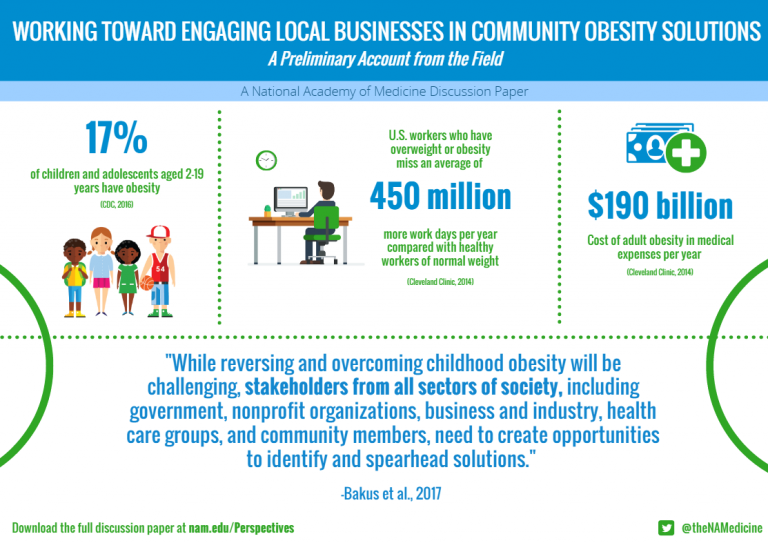
Share On Social!
Childhood obesity is a serious public health concern in the United States. About 12.7 million children and adolescents aged 2–19 years, or 17 percent of the population, have obesity.
For minorities, the statistics are even more troubling. Nearly 40% of Latino children are overweight or obese (higher rates than both white and black children), placing a significant burden on the current and future state of Latino health.
The National Academy of Medicine (NAM) has recently released a discussion paper in which they analyze the role that local businesses can play in alleviating this the childhood obesity epidemic.
Per the report (and in line with Salud America’s research) a lack of access to affordable, healthy foods, the absence of physical activity in schools and childcare centers, and a shortage of safe community spaces such as parks, sidewalks, and bike paths all contribute to obesity levels.
In addition to genetic and behavioral factors, the environments that children live, learn, and play also impact their overall health and well-being.
In order to reduce health disparities, it is critical to address inequities in programs, practices, and policies. Join our site, connect with others, and get involved.
Adult obesity takes a heavy toll on both individual and workforce health, as U.S. workers who have overweight or obesity miss an average of 450 million more work days per year compared with healthy workers of normal weight.
It also costs approximately $190 billion per year in medical expenses. Investing in childhood obesity solutions—whether through education, research, or greater community involvement—can support a healthier workforce and provide improved societal benefits for all.
“[Reversing] and overcoming childhood obesity will be challenging, stakeholders from all sectors of society, including government, nonprofit organizations, business and industry, health care groups, and community members, need to create opportunities to identify and spearhead solutions,” the paper said.
 The paper also points to the collaboration taking place in Cleveland, OH (10.5% Latino population), as an example of what can be done at the community level to alleviate the situation. Stakeholders in the city are beginning to galvanize multi-sector engagement in Greater Cleveland.
The paper also points to the collaboration taking place in Cleveland, OH (10.5% Latino population), as an example of what can be done at the community level to alleviate the situation. Stakeholders in the city are beginning to galvanize multi-sector engagement in Greater Cleveland.
Groups are actively “galvanizing local businesses in Greater Cleveland and establishing a framework for multi-sector community health improvement engagement that can be replicated in other cities.”
Additional findings of the paper include:
- Partnerships need to move from the transactional to the transformational. Guiding principles should include transparency, commitment, diversity, and ultimately trust.
- Success depends on community engagement. Community members are the lynchpin for an effective public health intervention.
- Where a community is located in relation to healthy eating and living opportunities represents a powerful influence in determining quality of life.
- Interventions should consider and be relevant for community members of varying socioeconomic status.
You can read the discussion paper in its entirety here.
Read stories similar to this one:
- The financial site @wallethub ranks the “Fattest Cities in America.” #SaludAmerica #HealthEquity http://salud.to/2nTlp12
- AThe @urbaninstitute’s new report uncovers the cost of segregation. #SaludAmerica #HealthEquity http://salud.to/2o6zhFz
By The Numbers
142
Percent
Expected rise in Latino cancer cases in coming years



